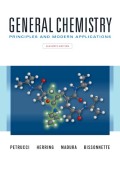
Concept explainers
(a)
Interpretation:
To determine the product of the following reaction and also the reason should be identified if the reaction will not occur.
Concept introduction:
A reaction absorbs energy for breaking the
(b)
Interpretation:
To determine the most probable outcome of the given reaction where aluminum oxide is heated.
Concept introduction:
A reaction consumes energy for breaking the chemical bonds present in the reactant molecules while chemical energy is released in the form of heat when formation of new bonds takes place.
(c)
Interpretation:
To determine the most probable outcome of the given reaction where gypsum is heated.
Concept introduction:
A reaction consumes energy for breaking the chemical bonds present in the reactant molecules while chemical energy is released in the form of heat when formation of new bonds takes place.
Want to see the full answer?
Check out a sample textbook solution
Chapter 21 Solutions
EBK GENERAL CHEMISTRY
- The carbon dioxide exhaled in the breath of astronauts is often removed from the spacecraft by reaction with lithium hydroxide 2LiOH(s)+CO2(g)Li2CO3(s)+H2O(l) Estimate the grams of lithium hydroxide required per astronaut per day. Assume that each astronaut requires 2.50 103 kcal of energy per day. Further assume that this energy can be equated to the heat of combustion of a quantity of glucose, C6H12O6, to CO2(g) and H2O(l). From the amount of glucose required to give 2.50 103 kcal of heat, calculate the amount of CO2 produced and hence the amount of LiOH required. The H for glucose(s) is 1273 kJ/mol.arrow_forwardWhat is Hrxn for reaction of iron(III) oxide and carbon monoxide to give iron metal and carbon dioxide gas? Use the following reactions: 4Fe(s)+3O2(g)2Fe2O3(s)H=1648.4kJ4CO(g)+O2(g)2CO3(g)H=565.98kJarrow_forwardOne of the few industrial-scale processes that produce organic compounds electrochemically is used by the Monsanto Company to produce1,4-dicyanobutane. The reduction reaction is 2CH2CHCH+2H++2eNC(CH2)4CN The NC(CH2)4CN is then chemically reduced using hydrogen gas to H2N(CH2)6NH2, which is used in the production of nylon. What current must be used to produce 150.kg NC(CH2)4CN per hour?arrow_forward
- The equation for the oxidation of phosphorus in air is P4(s) + 5 O2(g) P4O10(s). Identify the reactants and products and the stoichiometric coefficients. To what do the designations s and g refer?arrow_forwardFollow the directions of Question 29 for the following compounds: (a) solid ammonium nitrate (b) liquid methyl alcohol (c) solid copper(II) sulfidearrow_forwardA large sport utility vehicle has a mass of 2.5 * 10^3 kg. Calculate the mass of CO2 emitted into the atmosphere upon accelerating the SUV from 0.0 mph to 65.0 mph. Assume that the required energy comes from the combustion of octane with 30% efficiency. (Hint: Use KE = 1 /2mv2 to calculate the kinetic energy required for the acceleration.)arrow_forward
- Calculate the enthalpy of decomposing hydrogen iodide to produce hydrogen and iodine. 2HI(g) → I2(s) + H2(g) I2(s) → I2(g) ΔH⁰ = 124.8 kJ/mol I2(g) + H2(g) → 2HI(g) ΔH⁰ = - 73.0 kJ/molarrow_forwardHelp with question 6aarrow_forwardWhen heated, metal hydroxides decompose to produce a metal oxide and water. Selected the correct balanced equation for the decomposition of calcium hydroxide. CaOH (s) → CaO2 (s) + H2O (g) Ca(OH)2 (s) → CaO (s) + H2O (g) 2 CaOH (s) → 2 CaO (s) + H2O (g) 3 Ca(OH)2 (s) → 3 CaO2 (s) + H2O (g)arrow_forward
- Decide whether a chemical reaction happens in either of the following situations. If a reaction does happen, write the chemical equation for it. Be sure your chemical equation is balanced and has physical state symbols. A strip of solid silver metal is put into a beaker of 0.020M Sn(NO3)2 solution.arrow_forwardIdentify what type of chemical reaction this is: H2(g) + I2(s) ≈ 2Hl(g)arrow_forwardSelenic acid, H2SeO4, is produced from elemental selenium in a two-stage reaction. First the selenium isoxidized to selenous acid by nitric acid. Then the selenous acid is oxidized by potassium permanganate toselenic acid. The equations are:3 Se (s) + 4 HNO3 (l) + H2O (l) → 3 H2SeO3 (aq) + 4 NO (g)8 H2SeO3 (aq) + 2 KMnO4 (aq) → 5 H2SeO4 (aq)+ K2SeO3 (aq)+ 2 MnSeO3 (aq) + 3 H2O (l)What mass of selenic acid (in kg) can be produced from 1.00 kg of Se?Molar masses (g/mol): Se 78.96 H2SeO4 144.97arrow_forward
 Chemistry: Principles and PracticeChemistryISBN:9780534420123Author:Daniel L. Reger, Scott R. Goode, David W. Ball, Edward MercerPublisher:Cengage Learning
Chemistry: Principles and PracticeChemistryISBN:9780534420123Author:Daniel L. Reger, Scott R. Goode, David W. Ball, Edward MercerPublisher:Cengage Learning Chemistry: The Molecular ScienceChemistryISBN:9781285199047Author:John W. Moore, Conrad L. StanitskiPublisher:Cengage Learning
Chemistry: The Molecular ScienceChemistryISBN:9781285199047Author:John W. Moore, Conrad L. StanitskiPublisher:Cengage Learning ChemistryChemistryISBN:9781305957404Author:Steven S. Zumdahl, Susan A. Zumdahl, Donald J. DeCostePublisher:Cengage Learning
ChemistryChemistryISBN:9781305957404Author:Steven S. Zumdahl, Susan A. Zumdahl, Donald J. DeCostePublisher:Cengage Learning Chemistry: An Atoms First ApproachChemistryISBN:9781305079243Author:Steven S. Zumdahl, Susan A. ZumdahlPublisher:Cengage Learning
Chemistry: An Atoms First ApproachChemistryISBN:9781305079243Author:Steven S. Zumdahl, Susan A. ZumdahlPublisher:Cengage Learning
 Chemistry & Chemical ReactivityChemistryISBN:9781337399074Author:John C. Kotz, Paul M. Treichel, John Townsend, David TreichelPublisher:Cengage Learning
Chemistry & Chemical ReactivityChemistryISBN:9781337399074Author:John C. Kotz, Paul M. Treichel, John Townsend, David TreichelPublisher:Cengage Learning





